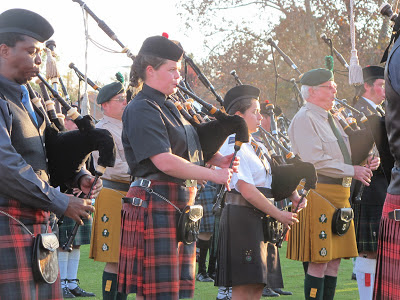South
Africa is famously labelled the 'Rainbow Nation' and is an incredible
country full of diverse traditions which are passionately upheld by
its many peoples. Rather randomly this weekend on Africa Day, the
local school of the area which we are currently living in, was
having a Highland Gathering, celebrating all things Scottish. As my
husband is from Scotland this was something we really had to see.
It is
not surprising to find Scottish culture and traditions being followed
in countries far from bonnie Scotland - even Moscow has a very active
Scottish community and I challenge you to find a modern capital city
without an Irish/Scottish/Celtic pub in it - but the level of dedication,
organisation, passion and skill that we saw at Johannesburg's
Highland Gathering was something else. Also the amount of tartan on
display was a joy to behold.
The
pipes, the pipes were most certainly calling.
At the
De La Salle Holy Cross College event (an event which I am reliably
informed is certainly not the biggest in the country) 15 different
piping bands from across the region (more if you include the junior
sections) were competing in different fields such as march,
strathsprey and reel. There was also a very impressive competition
for young drum majors (the guys at the front throwing around the
sticks) and a highland dancing competition which unfortunately we
missed.
The
large majority of South Africa's piping bands are connected with
prestigious local schools and some of these bands were formed as
recently as two years ago. However, there are also a number of bands
such as the Transvaal Scottish (1902) and the South African Irish
Pipes and Drums (1939) which trace their history back to military
regiments posted in the region in the early 20th Century.
 |
| At first I thought these guys were wearing Springboks colours, then I saw the gorgeous shamrock and harp detailing. Definitely my favourite kilts of the day |
Piping
became popular in South Africa during the years of British influence
when various Scottish and Irish regiments were based in South Africa.
Immigration from Scotland and Ireland also helped the music to
flourish and over the years playing in a piping band has become a
source of immense pride for youngsters of all backgrounds attending
schools with Celtic associations as well as for those of the older
generations who trace their roots back to the British Isles.
 |
| Old lads in kilts |
 |
| Young lads in kilts |
 |
| Marvellous hat and scarf tartan combo |
The
undoubted highlight of the Highland Gathering is seeing the massed
bands perform at the end of the day. All the bands which had competed
marched together across the playing fields to the sound of
traditional Scottish folk music -and yes, they even played the
Scottish national anthem Flower of Scotland! The sound and spectacle
was incredibly moving and I have to say it did make me feel quite
homesick, but in the best possible way.
At one
point it was announced that they would play Amazing Grace in memory
of one of the bands' former Drum Major's who had died from cancer that week.
A lone piper struck up the tune first before being joined by the
whole mass of hundreds of pipes and drums. The sound was
overwhelmingly beautiful. As the man standing next to me put it, it
was 'enough to bring a tear to a glass eye'.
The
Highland Gathering proved to be a really great family day out. There
were bacon butties and sausages on the barbeques, a beer tent (of
course), a big crafts market plus the chance to try your hand at some
fun and games such as throwing tomatoes at a man in a box (random
fun) and of course tossing the caber (traditional fun).
Some of
the strapping young lads from one of the bands made this caber tossing stuff
all look quite straightforward.
However as my husband found out - it's definitely not as easy as it looks.















































